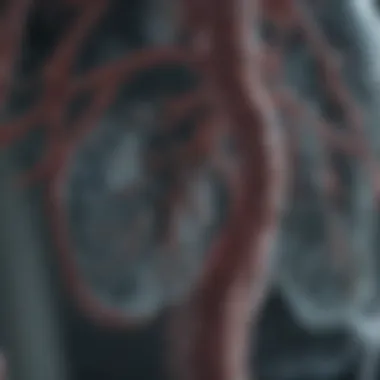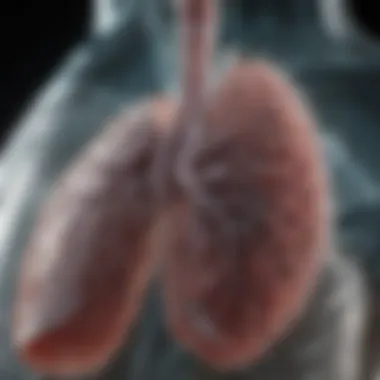Ground Glass Opacity in Lungs: Cancer Insights


Intro
Ground glass opacity (GGO) is a term commonly encountered in radiology, especially regarding the diagnosis of lung conditions. GGO presents itself on imaging studies as a hazy area that obscures the underlying vascular markings in the lung. It is crucial for clinicians to understand the implications of these radiological findings, given their potential association with both benign and malignant disturbances.
As cancer incidence continues to rise, identifying early indicators is essential for effective management. GGO remains a significant focus in the realm of lung cancer research and diagnosis. By exploring the nuances of GGO, we aim to uncover its relevance in enhancing the specificity and sensitivity of lung cancer diagnostics, thus supporting better patient outcomes.
Research Overview
Summary of Key Findings
Research on GGO has revealed several key insights:
- GGO can be associated with various types of lung cancer, including adenocarcinoma and other malignancies.
- The appearance and characteristics of GGO in imaging studies can vary significantly depending on the specific underlying pathology.
- Histopathological analysis of GGO is vital for a definitive diagnosis, as it provides context for the radiological findings.
Background and Context
Understanding GGO requires awareness of its development. Ground glass opacities may arise from various pathophysiological processes, including inflammation, infection, and neoplastic changes.
In the context of lung cancer, the presence of GGO often raises suspicion for lung adenocarcinoma, particularly when observed in certain demographic groups or associated with specific clinical symptoms.
Recent advancements in imaging technology have refined our ability to discern subtypes of GGO, enhancing diagnostic accuracy. The continued examination of GGO's implications in lung cancer diagnostics remains essential for ongoing research and development in pulmonary medicine.
Preface to Ground Glass Opacity
Ground Glass Opacity, commonly abbreviated as GGO, serves as a critical point of investigation within lung imaging studies. Its significance cannot be overstated, particularly when exploring its implications in cancer diagnosis. As a radiological finding, GGO manifests as a hazy area on imaging studies, distinct from solid masses, which may suggest various underlying conditions ranging from benign to malignant processes. Understanding GGO is essential for healthcare professionals, researchers, and students alike, as it allows for better interpretation of thoracic images and aids in guiding appropriate management.
The presence of GGO often captures the attention of radiologists. It alerts them to the potential for significant lung pathology. With the increase in lung cancer incidence, recognizing and interpreting these opacities is paramount to improve patient outcomes. This introduction highlights the essential elements surrounding GGO's definition and imaging techniques, preparing the reader for deeper exploration of its biological mechanisms, diagnostic challenges, and clinical implications in cancer research.
Defining Ground Glass Opacity
Ground Glass Opacity refers to a specific radiological appearance that is visible on computed tomography (CT) scans of the lungs. It appears as a translucent area within the lung parenchyma and indicates that the alveoli are filled with fluid or cells, but not completely. This partial filling leads to a loss of clarity, hence the term "ground glass". In essence, it signifies that something is obscuring the typical air space without forming a distinct mass.
GGO can be classified into various categories. These include:
- Transient GGO: sometimes seen in infections or inflammatory processes, which can resolve over time.
- Persistent GGO: which may be associated with chronic conditions such as interstitial lung diseases or malignancies.
The challenge is that GGO represents a spectrum of lung pathology. Not all GGO findings are indicative of cancer; they may signal conditions like pneumonia or pulmonary edema. Therefore, a precise definition and classification are crucial, as they guide subsequent diagnostic and clinical decisions.
Imaging Techniques for GGO Detection
Detecting Ground Glass Opacity predominantly involves imaging techniques, with High-Resolution Computed Tomography (HRCT) being the gold standard. HRCT uses thin-slice imaging that improves visualization of subtle findings like GGO. Compared to standard CT scans, HRCT can better delineate the boundaries of the opacity, allowing for a more accurate assessment.
While CT imaging remains the primary modality, other techniques can complement its findings:
- X-rays: While less sensitive, they can show large areas of opacity.
- MRI: This technique is infrequently used for lung pathology, but it can visualize certain masses associated with GGO.
- PET/CT Scans: These contribute valuable information regarding metabolic activity, assisting in differentiating malignant from benign processes.
In summary, a well-structured imaging strategy is essential for accurate GGO assessment. Diagnostic imaging enhances understanding of lung conditions, paving the way for timely and appropriate intervention.
Pathophysiology of Ground Glass Opacity
Understanding the pathophysiology of ground glass opacity (GGO) is essential for deciphering its implications in cancer diagnosis and research. GGO serves as a significant radiological marker that can indicate various pathological processes occurring in the lungs. Comprehending the biological and inflammatory mechanisms that lead to GGO formation aids healthcare professionals in making informed decisions regarding patient management, early diagnosis, and treatment strategies. Recognizing the diverse origins of GGO can further refine diagnostic approaches in identifying lung cancer among other conditions.
Biological Mechanisms Leading to GGO
The biological basis of GGO is complex and multifaceted. It commonly arises from the accumulation of fluid or cellularity in the alveolar spaces, causing a characteristic hazy appearance on imaging studies, particularly on computed tomography (CT) scans. This opacity is not solely indicative of malignancy but can also signal various benign conditions, such as infections, pulmonary edema, or interstitial lung diseases.
Key factors involved in the biological mechanisms include:
- Alveolar Damage: Damage to alveolar walls can result from inflammation, leading to the leakage of protein-rich fluid into these spaces.
- Cellular Infiltration: A buildup of inflammatory cells, particularly in immune responses to infections or neoplasia, can significantly contribute to GGO.
- Mucous Impaction: Excessive mucus production, seen in conditions like chronic obstructive pulmonary disease (COPD), can also lead to GGO formation.
Understanding these mechanisms helps in distinguishing whether GGO could be a precursor to malignancy or a manifestation of benign pathology.


Inflammatory Processes and GGO Formation
Inflammatory processes play a crucial role in the development of GGO. Inflammatory responses may trigger changes in the lung tissue architecture, affecting gas exchange and fluid dynamics. Several conditions can lead to inflammation resulting in GGO:
- Infectious Processes: Respiratory infections, such as pneumonia and viral infections like COVID-19, often lead to inflammatory infiltrates in the lungs, contributing to GGO.
- Interstitial Lung Disease: Conditions like sarcoidosis or idiopathic pulmonary fibrosis may also induce inflammation and scarring, leading to GGO on imaging.
- Tumor-Associated Inflammation: Lung cancers may create a local inflammatory environment that exacerbates the presence of GGO, complicating its interpretation in imaging studies.
Understanding how inflammation induces GGO is key to identifying its etiology and potential implications in cancer diagnosis.
Overall, unraveling the pathophysiology of GGO not only enhances clinicians’ ability to interpret imaging findings accurately but also encourages further research into its implications for early lung cancer detection and management strategies.
Association Between Ground Glass Opacity and Lung Cancer
Ground glass opacity (GGO) has gained attention in recent years due to its potential implications in lung cancer diagnostics. GGO represents a state where the normal lung architecture is obscured, but the underlying structures remain visible. This feature makes it critical in understanding how lung cancer manifests in imaging studies. Its presence can signify a variety of conditions, not just malignancies, which adds complexity to the diagnostic process. Thus, recognizing the association between GGO and lung cancer is fundamental for clinicians and radiologists.
Types of Lung Cancer Linked to GGO
Non-Small Cell Lung Cancer
Non-small cell lung cancer (NSCLC) comprises the majority of lung cancer cases. Its link to GGO is significant. Many tumors appear as GGO, particularly at early stages. This characteristic underscores the importance of GGO in diagnosing and monitoring NSCLC. The unique challenge with NSCLC is its varied histological types, each requiring different treatment approaches. Early identification through imaging allows for more effective management strategies. However, distinguishing true GGO from other lung pathologies can be difficult, leading to potential misdiagnosis.
Small Cell Lung Cancer
Small cell lung cancer (SCLC) is less common than NSCLC but is known for its aggressive nature. The relationship between SCLC and GGO is often less pronounced, although some studies note GGO can appear in advanced stages. Its rapid progression means imaging often reveals more solid nodules rather than GGO in later stages. Still, understanding any potential GGO in early SCLC is crucial for timely intervention. The early imaging detection of SCLC, including GGO, may help improve patient prognosis, despite the overall aggressive behavior of this cancer type.
Neuroendocrine Tumors
Neuroendocrine tumors (NETs) of the lung, while rarer, also show associations with GGO. The diagnostic imaging features of NETs can overlap with other lung nodules, making GGO identification vital. Often seen as hazy areas in radiological images, NETs can initially present as GGO. Recognizing this correlation is important for pathologists and radiologists. Treatment approaches differ from other lung cancers, which amplifies the need for accurate identification. The distinct biological behavior of NETs may require tailored management strategies, reinforcing the significance of understanding GGO in these contexts.
Clinical Significance of GGO in Oncological Diagnosis
The clinical significance of GGO lies in its capacity to aid in the early detection of lung cancer. Research indicates that despite the challenges, GGO presence in imaging can lead to more careful monitoring and follow-up, enabling better patient outcomes. Effective screening protocols that consider GGO can drastically alter the management of lung cancer. Low-dose computed tomography (CT) scans can play a pivotal role in uncovering subtle GGO changes, encouraging proactive medical interventions.
Understanding the variation in GGO presentations can directly influence cancer prognosis and therapeutic approaches.
Diagnostic Imaging Characteristics of GGO
The characteristics of ground glass opacity (GGO) in diagnostic imaging are crucial for accurate assessment and diagnosis of lung conditions. GGO is often subtle and sometimes obscured by other overlapping respiratory pathologies. Understanding these imaging features helps radiologists and clinicians distinguish GGO from other types of lung opacities, which is a key factor in formulating treatment strategies.
Radiologists utilize various imaging modalities to identify GGOs effectively. Among these, high-resolution computed tomography (HRCT) is predominant. The subtlety of GGO can present challenges, emphasizing the need for trained eyes and meticulous approaches in interpreting scans. Factors like the size, extent, and distribution of GGO contribute significantly to diagnosis. Also important is the context of clinical history, which aids in the interpretation of GGO's implications.
CT Imaging Features of GGO
CT imaging is the gold standard for evaluating GGO, providing a detailed visualization of lung structures. GGO typically appears as hazy opacities on CT scans. Unlike solid nodules, GGO does not obscure the underlying vascular structures, causing it to be more challenging to interpret. The appearance of GGO can vary based on its underlying cause. In some instances, it may represent early-stage cancer or inflammatory processes.
Several key characteristics are observed on CT imaging:
- Location: GGOs can appear in different areas of the lung, influencing differential diagnosis.
- Merging Patterns: Patterns may show coalescence with surrounding opacities, indicating complex pathology.
- Cavity Formation: Some cases may develop into cavitary lesions, providing clues about the underlying pathology.
Recognizing these features is essential for distinguishing between GGO and solid nodules, which often require different management strategies.
Differentiating Between GGO and Solid Nodules
Accurately differentiating GGO from solid nodules is a pivotal aspect of imaging interpretation. This differentiation can significantly influence management choices and prognostic outcomes. Solid nodules are typically opacities that entirely obscure the underlying lung structures, allowing for quicker diagnosis of malignancy, whereas GGOs may indicate a variety of non-malignant or malignant conditions.
Consider the following factors when distinguishing GGO from solid nodules:
- Density: GGOs are typically less dense compared to solid nodules. Their hazy appearance is a critical differentiator.
- Margins: GGOs often have irregular or indistinct margins. In contrast, solid nodules tend to have well-defined borders.
- Change Over Time: Monitoring changes in shape or size over time can indicate malignancy. GGOs that remain stable may be observed before intervention is considered.
"Understanding diagnostic imaging characteristics is essential for improving lung cancer detection rates and patient outcomes."
Histopathological Correlation of GGO


Understanding the histopathological correlation of ground glass opacity (GGO) is essential for comprehending its role in lung diseases, particularly in cancer diagnosis. This correlation refers to the connection between the GGO appearances detected through imaging studies and the actual tissue characteristics observed in histopathological examinations. This connection provides critical insights for clinicians and researchers alike, as it can influence diagnoses and guide treatment protocols. By examining the histopathology of GGO lesions, healthcare professionals can better distinguish between benign and malignant processes.
Tissue Analysis from GGO Lesions
Tissue analysis from GGO lesions is pivotal for obtaining definitive diagnoses. Obtaining biopsy samples from these lesions can yield valuable data about the underlying pathological processes. Histological examinations often reveal various cellular characteristics, including atypical cells indicative of malignancy. Moreover, the analysis allows for the identification of the tumor microenvironment. This includes evaluating the degree of fibrosis, inflammation, and the presence of associated lesions.
In addition, tissue analysis aids in confirming the types of lung cancer associated with GGO, including non-small cell lung cancer and small cell lung cancer. Pathologists can utilize various staining techniques, such as immunohistochemistry, to highlight specific markers that may indicate cancerous activity or other lung pathologies.
In summary, thorough analysis of GGO lesions can provide:
- Insights into tumor biology.
- Information on potentially aggressive features.
- A basis for developing individualized treatment plans.
Epithelial and Non-Epithelial Contributions
The contributions of both epithelial and non-epithelial components to GGO are significant. Epithelial cells typically line the airways and alveoli, reflecting the primary site of lung cancers. The presence of atypical epithelial cells is often a direct indicator of malignancy, with changes in cell morphology suggesting potential progression to cancer.
Non-epithelial elements, such as immune cells and fibroblasts, also play important roles in the context of GGO. Inflammatory responses often underpin the development of ground glass opacities, contributing to the pathophysiology of lesions. A comprehensive understanding of these interactions can shed light on mechanisms of disease progression and may support the development of therapeutic strategies.
The interplay of epithelial and non-epithelial factors is crucial in understanding the histopathological landscape of GGO.
Studying both types of components helps clarify whether GGO represents an inflammatory process or a neoplastic change. This understanding is valuable in establishing prognosis and guiding treatment decisions for patients diagnosed with lung lesions characterized by GGO.
Risk Factors Associated with GGO
Understanding the risk factors associated with ground glass opacity (GGO) is crucial in the broader context of lung health and cancer diagnosis. Knowing these factors can improve the screening processes and help healthcare professionals to identify patients who may need closer surveillance for lung cancer. Both environmental exposures and genetic predispositions play significant roles in the emergence of GGO.
Environmental Exposures and Lung Health
Environmental exposures are a significant contributor to lung health and can play a role in the presence of GGO. Numerous studies indicate that long-term exposure to pollutants can precipitate changes in lung tissue, leading to GGO. Common environmental hazards include:
- Cigarette Smoke: It isn't just the smoker; secondhand smoke significantly increases risk for non-smokers too.
- Airborne Pollutants: Urban living often exposes individuals to particulate matter and industrial emissions, which can damage lung cells.
- Occupational Hazards: Certain jobs expose workers to harmful substances like asbestos, silica, or heavy metals, known to be harmful.
Investigation into how these exposures correlate with GGO is ongoing. However, their role in the pathogenesis of lung disorders, including cancer, cannot be ignored. Research suggests that reduced air quality increases the likelihood of GGO appearing in CT scans, indicating an underlying pathology.
Genetic Predispositions to Lung Cancer
In addition to environmental factors, genetic predispositions contribute substantially to the risk of developing GGO and subsequent lung cancer. Genetic variations can affect individual susceptibility to insults that promote GGO. Factors include:
- Family History: Having a familial incidence of lung cancer may suggest an inherited risk.
- Genetic Mutations: Specific mutations, particularly in the EGFR gene, have been linked with lung cancer.
- Ethnic Background: Studies show that certain populations display a higher odds ratio for developing lung cancer linked to GGO.
Genetic testing may be beneficial for individuals with a high family history of lung cancer. As our understanding of the relationship between genetics and lung pathology deepens, it will likely enable better tailored screening strategies aimed at early detection of malignancies linked to GGO.
Key Takeaway: Understanding both environmental and genetic factors associated with GGO offers insight into prevention and early detection strategies for lung cancer.
Implications for Early Detection and Screening
Understanding the implications of ground glass opacity (GGO) in the context of early detection and screening is crucial. GGO serves as a signal within imaging studies that can indicate potential abnormalities in lung tissue. The identification of GGO can provide an opportunity for early intervention in lung cancer, a disease often detected at advanced stages.
Benefits of recognizing GGO early include improved patient outcomes, timely access to treatment options, and better prognostic information. An accurate interpretation of GGO can enhance clinical decision-making and tailor patient management strategies effectively.
However, there are important considerations when it comes to screening protocols. These should include the targeted population, frequency of screening, and the type of imaging technology utilized to detect GGO. The use of GGO in screening can also raise concerns regarding overdiagnosis and the psychological impact on patients due to potential false positives.
"The early detection of abnormalities such as GGO can significantly reduce lung cancer mortality if accompanied by appropriate follow-up and management strategies."
Screening Protocols and GGO
The design of screening protocols that incorporate the detection of GGO requires careful consideration. Current guidelines emphasize the need for risk assessment prior to initiating screening, focusing on individuals with significant risk factors for lung cancer. Criteria such as age, smoking history, and family history of lung cancer are commonly used to identify suitable candidates.
Moreover, screening protocols must specify the intervals for follow-up imaging. Frequent imaging can lead to more instances of GGO detection but may also result in increased anxiety for patients. Striking a balance between adequate surveillance and minimizing harm is vital.
Role of Low-Dose CT Scans in Lung Cancer Screening


Low-dose computed tomography (CT) scanning has emerged as a standard in lung cancer screening, especially for high-risk populations. The decreasing radiation exposure associated with low-dose CT scans makes it a preferable choice over conventional CT imaging, particularly when monitoring GGO. This technique allows for better visualization of lung structures and can identify subtle opacities that may not be evident on standard imaging.
Low-dose CT scans provide higher sensitivity in detecting GGO, which is essential for early intervention. Research indicates that patients with GGO identified through low-dose CT are at increased risk for developing lung cancer, making these scans critical for early identification and surveillance. Understanding the role of low-dose CT in screening programs is paramount for enhancing early detection efforts and tailored patient management.
Ongoing Research and Advances in Understanding GGO
Research on ground glass opacity (GGO) is rapidly evolving, and its implications in lung imaging are becoming clearer. Ongoing studies are essential for transforming the understanding of GGO. They not only address the diagnostic challenges but also pave the way for more effective patient management strategies. Researchers aim to delineate the biological mechanisms underpinning GGO and how it correlates with various pathologies, especially lung cancer. This comprehensive research effort can improve early detection and inform treatment plans, ultimately benefiting patient outcomes.
Innovative Imaging Techniques
New imaging methodologies are at the forefront of GGO research. Advances in chest CT technology, such as higher resolution scans and refined algorithms, provide clearer visuals of pulmonary structures. Innovations like digital tomosynthesis and artificial intelligence image analysis are gaining traction. These technologies can assist radiologists in distinguishing GGO from solid nodules, enhancing diagnostic accuracy.
- Artificial Intelligence: Machine-learning models analyze vast datasets to learn patterns significantly faster than human radiologists. They can flag suspicious areas that need further examination.
- Magnetic Resonance Imaging (MRI): While traditionally not used for lung imaging, MRI is being tested for its efficacy in evaluating GGO, offering a non-radiative alternative.
- Radiomics: By extracting data from medical images, radiomics provides quantitative information. This could potentially uncover patterns related to malignancy in GGO areas, providing new predictive markers for lung cancer.
The integration of these techniques signifies a major shift in lung Iamging, providing more precise assessments and enhancing research efforts to understand GGO.
Clinical Trials Investigating GGO
Clinical trials are pivotal for establishing the relevance of GGO in assessing lung cancer risk. Several trials are currently underway, focusing on the predictive value of GGO in lung cancer development. They aim to clarify the relationship between GGO characteristics and patient outcomes, particularly in early-stage assessments.
"Understanding how GGO influences prognosis is crucial for developing effective screening protocols and treatment approaches."
Current trials address questions such as:
- Surveillance Strategies: What are the most effective monitoring protocols for patients with observed GGO?
- Outcomes Correlation: How do GGO characteristics correlate with long-term outcomes in lung cancer patients?
- Treatment Responses: What are GGO's implications on the effectiveness of various treatment modalities?
These studies are essential in validating or refuting existing assumptions about GGO in clinical practice. The findings may lead to evidence-based guidelines that could standardize GGO evaluations in oncological practice.
Ongoing research in GGO encompasses a multidisciplinary approach, involving radiologists, oncologists, and researchers. As these innovations emerge, they enhance the foundation of lung cancer research and create pathways for better patient outcomes.
Management Strategies for Patients with GGO
Ground glass opacity (GGO) presents a distinctive challenge in medical practice. Understanding how to manage patients presenting with GGO is critical for optimizing outcomes. This section discusses the importance of management strategies for GGO patients, focusing on specific elements, benefits, and considerations that clinicians must take into account.
Patients with GGO require a tailored management strategy that acknowledges the complexity of this radiological finding. The ambiguity of GGO in relation to benign and malignant processes necessitates careful evaluation and scheduling of follow-ups. Monitoring is crucial. Continuous assessments can help to identify any changes in the GGO characteristics that may indicate malignancy progression.
Monitoring and Follow-up Protocols
Monitoring patients with GGO involves a systematic follow-up approach, often guided by imaging studies and clinical evaluations. Initial management typically includes:
- Baseline Imaging: A comprehensive CT scan should provide detailed anatomical information, serving as a reference for future comparisons.
- Patient History Review: Clinicians need to consider the patient's history, including smoking status, exposure risks, and family history of lung diseases.
- Schedule Regular Follow-ups: Protocols often suggest follow-up scans at three to six-month intervals, depending on initial findings and patient risk factors.These follow-ups are essential for determining whether there is stability, resolution, or growth of the GGO. Consistent monitoring increases the chances of early intervention if malignancy is detected.
Surgical and Non-Surgical Treatment Options
Management of GGO often leads to discussions about treatment options. Both surgical and non-surgical pathways exist, each with distinct advantages and implications.
- Surgical Options:
- Non-Surgical Options:
- Lobectomy or Wedge Resection: For patients with GGO associated with malignant potential, surgical resection may be considered. The decision hinges on the size, growth rate, and associated risk factors. Resection provides histopathological analysis and may eliminate the lesion.
- Video-Assisted Thoracoscopic Surgery (VATS): This minimally invasive approach may also be employed for diagnosing and treating suspicious GGO areas.
- Active Surveillance: Instead of immediate surgery, some patients may be managed with active surveillance. This may involve periodic imaging and assessments to monitor GGO.
- Targeted Therapies: In some contexts, treatment may pivot towards systemic therapies, dependent on tumor type and presentation.
Finale
The conclusion of this article highlights the significance of ground glass opacity (GGO) in lung cancer diagnosis and management. Understanding GGO is crucial for medical professionals, researchers, and patients alike. It represents a radiological phenomenon that can indicate various lung conditions, thus meriting careful analysis and interpretation.
Summary of Key Findings
In summary, several key points are essential in appreciating the implications of GGO:
- Association with Lung Cancer: GGO is frequently associated with lung cancers, particularly non-small cell lung cancer, small cell lung cancer, and neuroendocrine tumors. Its presence can be an indicator of malignancy and requires thorough investigation.
- Diagnostic Imaging Characteristics: CT imaging reveals specific features of GGO, making it an important tool for distinguishing GGO from solid nodules, which ultimately informs clinical decisions.
- Histopathological Correlation: You can find significant links between imaging and histopathology. The histopathological findings guide the understanding of the biological processes leading to GGO formation.
- Risk Factors: Pollution, smoking, and genetic predispositions are identifiable risk factors for conditions associated with GGO presentation. Understanding these factors aids in early detection strategies.
- Research Advances: Ongoing research into innovative imaging techniques and clinical trials is essential for refining our understanding of GGO's implications in lung cancer risk assessment.
Future Directions in GGO Research
Looking ahead, several pathways can shape future research on GGO:
- Refining Screening Protocols: Future studies might focus on optimizing screening protocols to enhance earlier detection of lung cancer in patients with GGO.
- Integrating Artificial Intelligence: Implementing AI in imaging analysis can improve diagnostic accuracy and help to categorize GGO more effectively.
- Longitudinal Studies: Conducting long-term studies will provide insight into the progression of GGO and its association with lung cancer over time.
- Genetic Studies: Further exploration into genetic predispositions related to GGO may reveal specific biomarkers, assisting in risk stratification.







